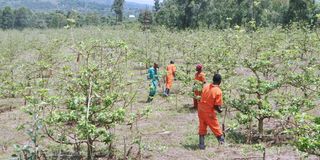Trees can be lucrative business, says Oketcho

Workers prune trees on Bwindi-Kihembe apple farm in Kanungu. Growing trees is a profitable business. PHOTO/Eronie Kamukama
What you need to know:
Since the beginning, trees have furnished us with two essentials: food and oxygen. As we evolved, they provided additional necessities such as shelter, medicine, and tools. Most farmers are yet to take up tree planting as a serious agricultural venture that could boost their incomes. In an interview with Prosper’s Martin Luther Oketch, the chairman – Uganda Timber Growers Association (UTGA), Mr. Solomon Ossewe Oketcho discusses the importance of tree business in Uganda.
Why is tree growing for commercial purposes important?
It is a profitable investment that contributes to the wellbeing of the environment through carbon sinking and other ecosystem services. It also provides jobs along the commercial forestry value chain and contributes to people’s livelihoods (firewood, water, medicines among others). It improves lives by mitigating climate change and its effects. One can make money from selling timber, poles and other wood products.
It conserves and protects Mother Nature’s biodiversity. It contributes to rain formation; related benefits to the environment. It provides fuel wood for energy and saving forest degradation and deforestation.
It creates an alternative to the home of the wild, cleaning the air we breathe by producing oxygen and sequestration of carbon. Increasing the value of land.
How much land is needed to grow trees for commercial purposes?
Since 1990, Uganda has been losing its forest cover by over 120,000 per hectare annually according to recent studies. This translates to the area required for commercial tree growing since it has proven to be the surest way of replenishing Uganda’s forest cover. However at individual level, there is no small piece of land. Some people even plant along their boundaries and still benefit.
Where in Uganda is tree growing for commercial purposes practised at a large-scale level?
All large-scale commercial forest establishments are in CFRs particularly in Kikonda Central Forest Reserve (CFR) in Kyankwanzi, Bukaleba CFR in Mayuge, Namwasa, Luwunga and Kirinya in Mubende, Kiboga and Bugiri respectively. However, as far as the cumulative acreage is concerned, the Albertine cluster (Hoima, Masindi, Kiboga, Kyankwanzi) has the biggest acreage of plantations (above 25,000ha) followed by the Mubende cluster.
What investment opportunities does tree growing offer to Ugandans?
The major investment opportunity is the production of forest products, particularly timber, utility poles, fuel wood and other products that include; tree nurseries, forest operation contract services for example clearing, pitting, planting, weeding, pruning, thinning plus the provision of other technical services such as mapping. Investment in wood processing services like harvesting, sawmilling and other forms of value addition. Investments in timber trade and related logistics, for example, transport, storage and grading.
It also provides an ecosystem of services sucn as carbon trade.
How many people in Uganda carryout tree growing as a business venture?
This is not easy to determine since only a given number come out to be known by being part of organised groups like UTGA, however, according to Uganda Bureau of Statistics (UBOS) – 22.9 per cent of Ugandans engage in tree planting.
What type of trees is recommended for people to grow for commercial purposes?
This depends on the management objective but includes Pine, Eucalyptus, Teak, Maesopsis Eminii (Musizi) and some other fast growing indigenous species like Terminalia Superba are grown due to their known profitability. Some grow eucalyptus for transmission poles, but all these species can be converted into fuel wood.
Where is the market for tree products (timbers) found?
Currently, most of the timber grown in Uganda is consumed locally for the construction and other industrial purposes. Utility poles are consumed locally for power extension while the smaller poles are used for farm fencing scaffolding there is a huge regional market especially for construction and industrial timber although only a few Ugandans have tapped into it.
How many years do trees require to mature for wood/timber harvesting?
This depends on the product or objective of planting and species. Pine requires 15 to 18 years to mature. Eucalyptus is harvested at 15 or more years for timber and eight to 10 years for utility poles although eucalyptus has a multitude of other uses that may lead to earlier harvesting for scaffolds and animal shelter.
How much does trees (forest products) contribute to Uganda’s economy?
In 2015/16, the forestry sector accounted for 18 per cent of the Gross Domestic Product (GDP).
Is there a need for one engaged in tree farming to take care of it, in the form of weeding the farm?
Yes, just like other crops, trees must be cared for. One must carry out weeding often, pruning and thinning among others.
How many tonnes of wood/timber is being realised in Uganda on an annual basis?
Just above 800,000 cubic metres.
You are now the chairperson of the association promoting tree growing as a business. How will this benefit Ugandans?
Lobbying and advocacy to create a conducive environment within which tree growers need to operate fairly and for value. Provision of extension services to include outreach, training and networking. Providing inputs at subsidised prices for example seeds, seedlings, tools, chemicals and linking growers to other services at discounted rates. Creating and maintaining beneficial partnerships.
It creates market linkages, contributes to research and development especially on the profitability of commercial plantations and protection against pests and diseases.
How do you view the future of tree growing for money in the next five years?
Tree growing is expected to grow exponentially over the next five years and UTGA has noted an increase in individuals, corporate companies and a wide range of investors are increasingly picking interest in commercial tree growing.




